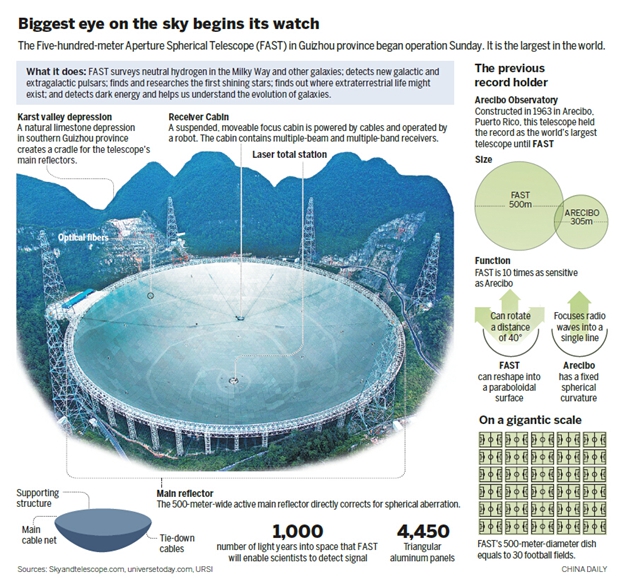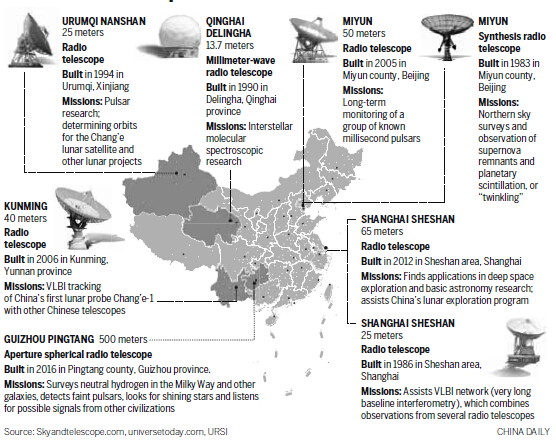Gigantic telescope will push Chinese science to forefront - and the world is invited to share
Scientists of the world take note: You are invited by China to listen for alien life through the largest telescope ever built.
With the massive facility officially coming into operation on Sept 25, leading scientists told China Daily that foreign scientists will be welcome to use China's gigantic five-hundred-meter Aperture Spherical Telescope, known as FAST.
It is a single-aperture telescope the size of 30 football pitches, located in Guizhou province in southwestern China.
The facility, surpassing the second-largest by 200 meters in diameter, is being described as a game-changer in space research.
President Xi Jinping sent a congratulatory letter to the scientists and engineers who contributed to its creation.
"The launch of FAST symbolizes a major breakthrough in China's science research and has great significance for the country's strategy to push forward innovation," Xi said in the letter.
FAST will search for gravitational waves, detect radio emissions from stars and galaxies, and listen for signs of intelligent extraterrestrial life, scientists say.
"The ultimate goal of FAST is to discover the laws of the development of the universe," says Qian Lei, an associate researcher with the National Astronomical Observatories, part of the Chinese Academy of Sciences, which built the telescope.
|
ss
ss
ss
 |
"In theory, if there is civilization in outer space, the radio signal it sends will be similar to the signal we can receive when a radiation beam from a pulsar (spinning neutron star) is approaching us."
Zhang Shuxin, deputy general manager of the project, says foreign scientists can start conducting their own space research at FAST once debugging is completed.
But before that is done, "we wouldn't feel very good" about distributing time slots to foreign astronomers, he says.
"It's such a huge thing, you see," Zhang says. "And the technologies we use in both its driving device and reflecting surface are entirely new to us.
"As the first step, a parabola of 300 meters in diameter will be formed on the surface, with the help of the driving device, and will start receiving signals," he explains. "We need to gather experience and develop methodology to ensure detection accuracy for that."
It may be three to five years before FAST can guarantee its best performance, Zhang adds.
FAST's large hemispheric surface is made up of 4,450 1.3-millimeter-thin reflecting panels, each weighing 427 to 482.5 kilograms. The first panel was installed in August 2015. Patching all the panels together took 11 months.
Sun Caihong, deputy chief engineer for FAST, says the telescope's operators will focus on strong radio sources already known to them. He says scientists are also expecting to make some progress in research by analyzing data they receive in the debugging.
Wang Qiming, chief engineer for FAST, says: "We would like to finish debugging quickly. FAST will be the world leader in 10 to 20 years. We would like to make full use of this period."
FAST has already had a good start, scientists say. In a recent test, it received a set of high-quality electromagnetic waves sent from a pulsar about 1,351 light years away.
It was the best-quality signal that FAST had received since it started its trial observation in mid-September.
Wang says the most challenging part of debugging is adjusting the laser that performs measuring tasks on the reflecting surface. As long as the laser measuring device detects errors in a timely way, scientists can make immediate adjustments.
The telescope is located in an almost-perfect spherical landform, so there was no need to dig a hollow for it. The valley in Guizhou was chosen also for its karst (rocky limestone) landform, which ensures good drainage, meaning rainwater won't gather and damage the reflecting surface
Philip Diamond, director-general of Square Kilometer Array, a large multiradio telescope project to be built in Australia and South Africa, says: "FAST is the biggest single dish in the world. It will have new technology, and a new receiver system, to be much more efficient. Astronomers and scientists are queuing up all around the world to use it."
Diamond says the SKA, an international project in which China is a member, will be even larger than FAST.
"But ours won't be in the form of one single dish. It will be hundreds and thousands of smaller dishes spread over a large area. They will work together," he says.
"You can think of FAST as a wide-angle lens and the SKA as a zoom lens. FAST will find a lot of objects, and SKA will offer a lot of details on these objects. They will be very complementary."
Anthony Beasley, director of the National Radio Astronomy Observatory in the United States, says there are many areas of radio astronomy in which FAST will bring Chinese astronomers to the fore.
He says it will likely be two to three years, while the telescope is brought to its full strength, before they can use it.
Construction of the nearly 1.2 billion yuan ($179 million; 160 million euros; 138 million) FAST project started in 2011, 17 years after it was proposed by Chinese astronomers.
By Hou Liqiang and Yang Jun (China Daily Africa)
|
What the world says The construction of this telescope is seen by some as part of a growing desire on behalf of China to press its interests in the geopolitical realm.
The massive construction project has the potential to be a game-changer for our understanding of the universe, and our search for life on other planets.
China is now on track to become a world leader in the space race, which its leaders view as confirmation of Beijing’s growing superpower status.
But projects like the Fast telescope are powerful symbols of a scientific renaissance.
|
Where China's telescopes are
 |
|
|
|
|
|
|
|
|